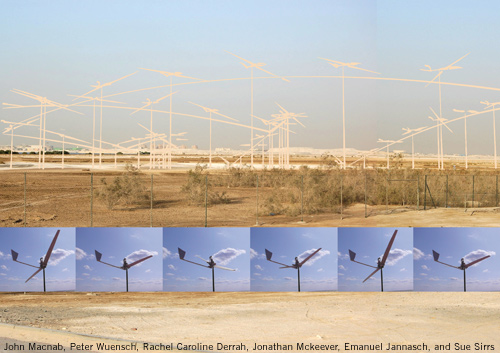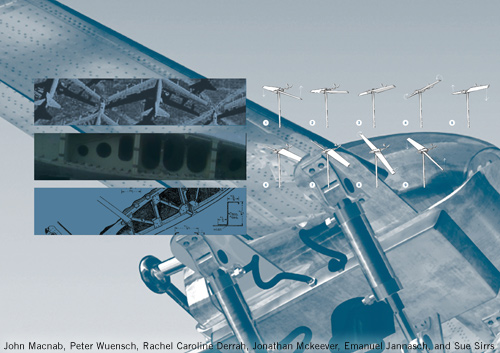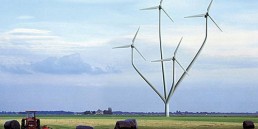John Macnab + Peter Wuensch and Rachel Caroline Derrah with Breakhouse Inc. + Jonathan Mckeever + Emanuel Jannasch + Sue Sirrs with Outside! Planning and Design Studio
Designed for Site #1 in Dubai, adjacent to Ras Al Khor Wildlife Sanctuary.

Design Submission for the 2010 Land Art Generator Initiative Design Competition
Artist’s descriptive text:
1. The Challenge
Wind energy is an abundant source of benign energy, but conventional turbines are proving troublesome both ecologically and aesthetically. Ecology and aesthetics are not disconnected, and we believe that ways of extracting energy from the wind that are in closer concord with animal life will inevitably be more appealing to humans.
Energy Concept
Wind energy is captured by a flight of reciprocating airfoils driving reciprocating pumps. Accumulated fluid pressure is released as required to perform mechanical work locally, or perhaps to generate electricity for transmission. Site specific work might include irrigation, water pumping or desaliniztion.
Rhythm
High speed rotation is lethal to creatures in the air and unsettling to humans on the ground. Accumulating energy as hydraulic pressure allows us to reduce wing velocities. Organic mechanisms are not rotational but reciprocating. We find that reciprocating pumps can use heart-like bellows and flaps instead of discrete moving parts subject to friction and contamination. Driving pump-beats directly from wing-beats simplifies the device technically and animates it aesthetically.

Philosophy
Artifacts and ideas are not unnatural, they are a component of nature, extensions of the same energy and information processes that we recognize as organisms and ecosystems. We are not externalizing nature and then imitating it. With this project we wish to demonstrate that we are one branch of nature learning to live in a healthier exchange with others.
State of the Art
The suitability of reciprocating wind machines has been studied by Dr. Simon Farthing and his oscillating single wing pump (econologica.org) . The concepts are, by choice or time, in the public domain. Searches show our own bilateral system to be novel in design although we are not protecting it at present. Our small scale (and therefore higher speed) proof-of-concept prototype can be seen here:
Evolution
Concept is scalable extendable to the aspirations of the larger project.
2. REUSE
Of Material
The key to our proposal technically and aesthetically are the wings, which we will make from aviation salvage. As the wings work on the upbeat as well as the downbeat, we will use symmetrical foils such as rudders and elevators. We are combing the world of high-tech salvage yards for more parts that are as beautifully made and as suited to their purpose.

Of Energy
Sophisticated elements such as airplane parts are tragically worthless as scrap, because their value lies in their very lightness. In reusing highly manufactured parts without reducing them to simple materials, we are not only using the material, but saving the energy embodied throughout their many stages of making.
Of Ideas
In re-deploying a highly crafted artifact, we are preserving not only embodied matter and energy, but embodied ideas, calculations, techniques, inventions, all the information that nature has processed through us and through them. Not only as a static record but as HUMOUS *, participating dynamically in the world.
Negentropy
Of course, many components will be created “new”. Our policy will be to use the highest order of material appropriate to the situation; whether prepared by “nature” such as plant fibres and gums or refined and composed by “artificial” means.
* HUMOUS’08, the First International Conference on Humans Operating Unmanned systems was held in Brest, France, 3-4 Sept. 2008.

3. FORM
Sharing
honeycomb
as social creatures we pool our resources. Energy is stored in the lower grade form of pressure, and is only converted to higher grade forms, such as turbine generated electricity, when and as needed.
Tubes
microscopic wood grain
This capitalizes on the available structural cavities and avoids ecological cost of batteries. Storage is not in a single accumulator subject to catastrophic failure, but throughout the structural mesh of tubes, and protected at each joint by a simple reed valves.
Circulation
branching pattern from Peter Stevens or Vein-Artery drawing
This is a recirculating system operating through complementary dendritic systems of “veins” and “arteries”. Diameters and angles will vary in response to flows.
Hinges
insect or lobster elbow
hinges are based on flexibility rather than friction.
Bellows
heart
systole and diastole are achieved without discrete moving parts.
4. LIFE AND LAND
The Sky
Our flock of waterbirds draws an uplifted curve against the horizon, and a gentle curve across the prevailing winds. Just as this compound curvature minimizes turbulent interference even at the rare times when the wind blows along the formation, it also provides an ever changing perspective as we pass around under and over it.
The Air
Initial consultation with the retired Director and Biologist/Consultant David Kerr at Algonquin Power and Utilities Corporation a leading Canadian renewable energy Company, confirms our intuition that our low velocity airfoils will be a much friendlier participant in avian and mammalian airspace than the standard industrial impeller has turned out to be and that the project as it stands should be compatible with wild bird populations around the world. We are currently discussing the design with Donald E. Harron B.sc. , P.Biol., R.P.Bio. a lead Scientist in wind farms EA., as recommended by Algonquin Power.
Sound
We creatures evolved in an context of rushing and whispering noise, against which pure tones were articulated by birds, bugs, beasts, and humans into call and song. Machines have intruded on this acoustic structure by introducing pure tones as mere garbage, the wasteful, tuned, vibrations of steady-speed action. This has become one of the main drawbacks of rotary wind machines. The wings of our water-birds are continuously accelerating and decelerating and will not be able to produce generate consistent frequencies. The collective beating of the flock will always be out of phase and out of pitch with one another, creating the kind of background against which life and thought have flourished.
The Earth
Our participation in a “wilderness” is not seen as an intrusion to be minimized but as an enrichment to be orchestrated. This principle will pervade all our activity on site. The masts are the most significant development of topography, and we will develop their microclimatic potential at several scales.
Nest and Trellis
The pylons of industrial wind-generators are thin, circular monoliths minimizing the wind shadow cast on the impeller. Our water birds never fly behind the mast, which may therefore be built with less material under lower stress as a lattice structure. This will be detailed to extend the biome both of plant and animals, inhabiting a different wind-niche. As in a tree, tubular grain is used structurally structure will be used for conduction of fluid.
Trunk and Root
The highly stressed conventional pylon requires a massive foundation and disruptive excavation. By matching width to bending moments, the lattice tower reduces stresses, and connects to the ground through several small and dispersed anchor points. Structural roots become fluid conduits between masts, and so serve as pressure accumulators. Shallow excavation can be an opportunity to invigorate soil strata.

